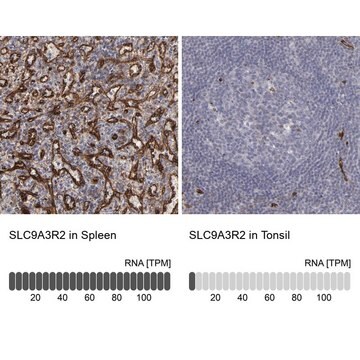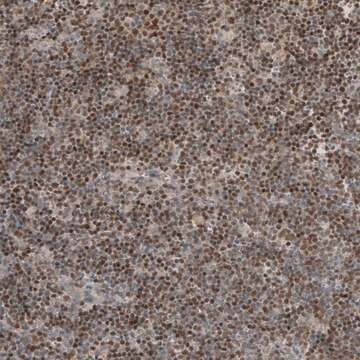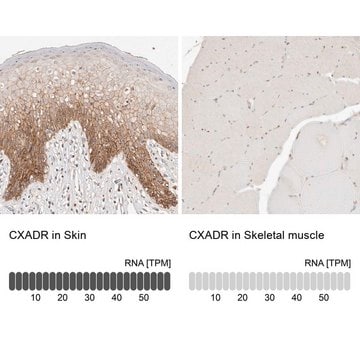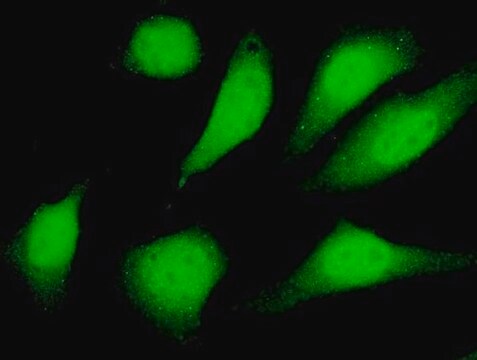一般說明
We are committed to bringing you greener alternative products, which adhere to one or more of The 12 Principles of Green Chemistry.This antibody is Preservative-free, produced without the harm or sacrifice of animals and exceptionally stable to allow for ambient shipping and storage if needed and thus aligns with "Waste Prevention", "Designing Safer Chemicals" and "Design for Energy Efficiency".
Click here for more information.
ZooMAb® antibodies represent an entirely new generation of recombinant monoclonal antibodies.Each ZooMAb® antibody is manufactured using our proprietary recombinant expression system, purified to homogeneity, and precisely dispensed to produce robust and highly reproducible lot-to-lot consistency. Only top-performing clones are released for use by researchers. Each antibody is validated for high specificity and affinity across multiple applications, including its most commonly used application. ZooMAb® antibodies are reliably available and ready to ship when you need them.
特異性
Clone 1D19 is a ZooMAb® Rabbit recombinant monoclonal antibody that specifically detects Coxsackievirus and adenovirus receptor (CAR). It targets an epitope within 25 amino acids from the N-terminal, extracellular domain.
免疫原
KLH-conjugated linear peptide corresponding to 25 amino acids from the N-terminal, extracellular domain of human Coxsackievirus and adenovirus receptor (CAR).
應用
Quality Control Testing
Evaluated by Immunohistochemistry (Paraffin) in human prostate tissue sections.
Immunohistochemistry (Paraffin) Analysis: A 1:100 dilution of this antibody detected CXADR/CAR in human prostate tissue sections.
Tested applications
Immunocytochemistry Analysis: A 1:100 dilution from a representative lot detected CXADR/CAR in HepG2 cells.
Western Blotting Analysis: A 1:10,000 dilution from a representative lot detected CXADR/CAR in HepG2 cell lysate.
Western Blotting Analysis: A 1:10,000 dilution from a representative lot detected His-Tagged recombinant fragment of Human CXADR/CAR.
Affinity Binding Assay: A representative lot of this antibody bound CXADR/CAR) with a KD of 1.3 x 10-8 in an affinity binding assay.
Note: Actual optimal working dilutions must be determined by end user as specimens, and experimental conditions may vary with the end user
標靶描述
Coxsackievirus and adenovirus receptor (UniProt: P78310; also known as CAR, hCAR, CVB3-binding protein, Coxsackievirus B-adenovirus receptor, HCVADR, CXADR) is encoded by the CXADR (also known as CAR) gene (Gene ID: 1525) in human. CXADR is a single-pass type I membrane protein that is synthesized with a signal peptide (aa 1-19), which is subsequently cleaved off to produce the mature form that contains an extracellular domain (aa 20-237), a transmembrane domain (aa 238-258), and a cytoplasmic domain (aa 259-365). It is palmitoylated on Cys 259 that enables its proper localization to the plasma membrane. CXADR is a component of the epithelial apical junction complex that may function as a homophilic cell adhesion molecule and is shown to be essential for tight junction integrity. It is also involved in transepithelial migration of leukocytes through adhesive interactions with JAML. The interaction between both receptors also mediates the activation of T-cells. Upon epithelial CXADR-binding, JAML induces downstream cell signal transduction events in T-cells through PI3-kinase and MAP kinases that results in proliferation and production of cytokines and growth factors by T-cells to stimulate epithelial tissues repair. Loss of CXADR in mice is reported to cause numerous embryonic defects leading to abnormal development of the cardiovascular system and embryonic lethality between E11.5 and E13.5. This ZooMAbZooMAb® recombinant monoclonal antibody, generated by our propriety technology, offers significantly enhanced specificity, affinity, reproducibility, and stability over conventional monoclonals. (Ref.: Outhwaite, JE., et al. (2019). Front. Physiol. 10; 622; Cohen, CJ., et al. (2001). Proc. Natl. Acad. Sci. USA. 98(26); 15191-15196).
外觀
Purified recombinant rabbit monoclonal antibody IgG, lyophilized in PBS, 5% Trehalose, normal appearance a coarse or translucent resin. The PBS/trehalose components in the ZooMAb formulation can have the appearance of a semi-solid (bead like gel) after lyophilization. This is a normal phenomenon. Please follow the recommended reconstitution procedure in the data sheet to dissolve the semi-solid, bead-like, gel-appearing material. The resulting antibody solution is completely stable and functional as proven by full functional testing. Contains no biocide or preservatives, such as azide, or any animal by-products. Larger pack sizes provided as multiples of 25 μL.
重構
300 μg/mL after reconstitution at 25 μL per vial. Please refer to guidance on suggested starting dilutions and/or titers per application and sample type.
儲存和穩定性
Recommend storage of lyophilized product at 2-8°C; Before reconstitution, micro-centrifuge vials briefly to spin down material to bottom of the vial; Reconstitute each vial by adding 25 μL of filtered lab grade water or PBS; Reconstituted antibodies can be stored at 2-8°C, or -20°C for long term storage. Avoid repeated freeze-thaws.
法律資訊
ZooMAb is a registered trademark of Merck KGaA, Darmstadt, Germany
免責聲明
Unless otherwise stated in our catalog or other company documentation accompanying the product(s), our products are intended for research use only and are not to be used for any other purpose, which includes but is not limited to, unauthorized commercial uses, in vitro diagnostic uses, ex vivo or in vivo therapeutic uses or any type of consumption or application to humans or animals.










